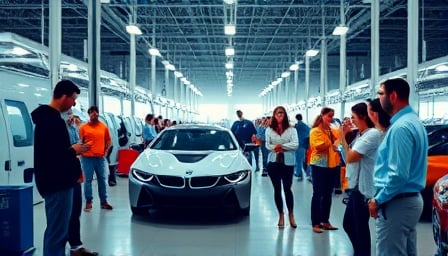BMW’s Bold Leap into the Electric Future: A Strategic Playbook or a Reckless Gamble?
BMW has once again positioned itself at the center of the automotive conversation, announcing a series of moves that could redefine its trajectory and reshape the entire industry. The German automaker’s latest announcements—an audacious new electric vehicle, the iX3, and a high‑tech partnership with Qualcomm—signal a decisive pivot toward electrification and autonomy. Yet, beneath the surface of this narrative of innovation lies a deeper question: Is BMW truly steering the future, or merely following the inevitable tide?
The iX3: A “Game‑Changer” with a Flashy Face
BMW’s unveiling of the iX3 is being heralded as a watershed moment. The vehicle promises an impressive range of up to 800 km and a formidable 469 PS motor, positioning it squarely against the likes of Tesla and new Chinese entrants. At first glance, these specs paint the iX3 as a genuine threat to the status quo. However, the numbers also raise eyebrows:
- Range Claims vs. Reality: While the 800 km figure is enticing, it relies on idealized test cycles. In real‑world conditions—especially in European climates—actual range is likely to fall short, undermining the “game‑changer” label.
- Power vs. Brand Identity: BMW’s hallmark has been driving dynamics, not raw horsepower. The 469 PS engine, while powerful, may not resonate with the brand’s performance‑centric audience.
By positioning the iX3 as its first entry into the “New Class,” BMW attempts to signal a strategic shift toward electric dominance. Yet, the move also places the company in direct competition with the very Chinese automakers that are rapidly eroding BMW’s traditional market share. Is this a bold countermeasure, or a reactive scramble to keep pace?
A Preemptive Strike Against the EU’s 2050 Mandate
The European Union’s impending ban on thermal vehicles by 2050 is a looming threat for any automaker. BMW’s accelerated push into electrification can be seen as a preemptive strategy to sidestep regulatory penalties and position itself as an industry leader. However, the speed of this transition is critical. While the iX3 is a step forward, the broader shift to a fully electric fleet—both in production and product lineup—remains a formidable logistical and financial challenge.
Snapdragon Ride Pilot: Hands‑Free Driving or Marketing Ploy?
In partnership with Qualcomm, BMW is introducing Snapdragon Ride Pilot, a driver‑assistance system slated for debut in the iX3 in 2026. The system promises hands‑free driving, automatic lane changes, and parking assistance—features that, on paper, could revolutionize daily commuting. Yet, the practical realities are far more complex:
- Technology Adoption Lag: Even the most advanced autonomy systems take years to reach market readiness. Deploying a 2026 launch risks the system being outdated when it finally hits the road.
- Regulatory Hurdles: Hands‑free driving remains a contentious issue, with stringent safety requirements that could delay or even block deployment.
- Consumer Skepticism: German drivers, long accustomed to manual control, may resist relinquishing the “hands‑on” experience that BMW has historically championed.
Market Reactions: Stability Amid Turbulence
Despite these ambitious announcements, BMW’s stock has not experienced a dramatic surge. The DAX’s 0.7% decline on Friday, driven by weak U.S. labor market data, mirrored a broader market caution. BMW’s shares, however, remained relatively stable, reflecting investor confidence in its long‑term strategy. Nonetheless, the market’s muted reaction underscores a critical reality: lofty claims and flashy tech can only go so far when the underlying fundamentals—profitability, production scalability, and supply chain resilience—remain uncertain.
Innovation vs. Sustainability: A Thin Line
BMW’s narrative of innovation and sustainability is compelling, but it must be weighed against operational realities. The shift to electrification demands massive capital investment in battery technology, charging infrastructure, and workforce training. The partnership with Qualcomm adds another layer of complexity, as it requires seamless integration of disparate tech ecosystems. Whether BMW can maintain its traditional engineering excellence while embracing these new frontiers remains to be seen.
Conclusion: A Calculated Risk or an Overambitious Gamble?
BMW’s recent announcements are undeniably bold. The iX3’s performance specs and the Snapdragon Ride Pilot’s promise of hands‑free driving are both attention‑grabbing. Yet, the strategic underpinnings—responding to EU regulations, countering Chinese competition, and maintaining market stability—reveal a company navigating a precarious balance.
The question isn’t whether BMW is committing to innovation; it’s whether these moves translate into tangible market advantage. If the iX3 can deliver real‑world performance that outshines competitors, and if Snapdragon Ride Pilot can overcome regulatory and consumer hurdles, BMW could indeed cement its place as an electrified pioneer. Until then, the industry—and investors—will keep a wary eye on how the company turns these ambitious plans into profit‑driven realities.
